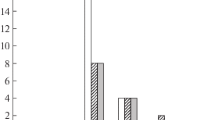Summary
Two interferon components having different molecular weights were determined by gel filtration studies in non-purified rabbit serum interferon obtained 4 hours after intravenous administration of 200 μg poly I∶C. The high molecular component (M.W. ≧100,000) corresponded to a minor part (16.85 per cent) of the total interferon activity. The low molecular components has a molecular weight of 50,000–55,000 and was more heat stable than the high molecular component. By comparison with the interferon induced by Newcastle disease virus under the same conditions it appeared that, though the elution patterns from Sephadex G-100 of both the interferons were similar, there were differences in physicochemical properties of separate components: the high molecular poly I∶C-induced component was not affected by treatment with 4m urea (the high molecular component induced by NDV was completely inactivated) and it was also more heat stable than the corresponding component of the NDV-induced interferon.
Similar content being viewed by others
References
Field, A. K., G. P. Lampson, A. A. Tytell, M. M. Nemes, andM. R. Hilleman: Inducers of interferon, and host resistance. IV. Double-stranded replicative form of RNA (MS 2-RF-RNA) fromE. coli infected with MS 2 coliphage. Proc. nat. Acad. Sci. (Wash.)58, 2102–2108 (1967).
Field, A. K., A. A. Tytell, G. P. Lampson, andM. R. Hilleman: Inducers of interferon and host resistance. II. Multistranded synthetic polynucleotide complexes. Proc. nat. Acad. Sci. (Wash.)58, 1004–1010 (1967).
Kadri, A., undH. Kohlhage: Physikalisch-chemische Eigenschaften myxovirusinduzierter Seruminterferone des Kaninchens. Arch. ges. Virusofrsch.28, 51–62 (1969).
Ke, Y. H., andM. Ho: Studies on the physico-chemical inactivation of rabbit interferons. Proc. Soc. exp. Biol. (N.Y.)129, 433–438 (1968).
Ke, Y. H., M. Ho, andT. C. Merigan: Heterogenity of rabbit serum interferons. Nature (Lond.)211, 541–542 (1966).
Lampson, G. P., A. A. Tytell, A. K. Field, M. M. Nemes, andM. R. Hilleman: Inducers of interferon and host resistance. I. Double-stranded RNA from extracts of Penicillium funiculosum. Proc. nat. Acad. Sci. (Wash.)58, 782–789 (1967).
Maehara, N., andY. Nagano: Heat-labile virus-inhibiting factor or interferon induced by virus. Jap. J. Microbiol.14, 257–260 (1970).
Nagano, Y., andN. Maehara: Molecular weight species of virus-inhibiting factor or interferon produced in the rabbit. Jap. J. Microbiol.16, 433–435 (1972).
Siegert, R., H. L. Shu, andH. Kohlhage: Correlation between fever and interferon titer in rabbits after induction with myxoviruses. Life Sci.6, 615–620 (1967).
Smith, T. J., andR. R. Wagner: Rabbit macrophage interferons. II. Some physicochemical properties and estimations of molecular weights. J. exp. Med.125, 579 to 593 (1967).
Táborský, I., andH. Kohlhage: Production of endogenous pyrogen after interaction of different rabbit blood leukocyte types with Newcastle disease virus or endotoxin. Acta virol.16, 226–233 (1972).
Author information
Authors and Affiliations
Rights and permissions
About this article
Cite this article
Táborský, I. Heterogeneity of rabbit serum interferon induced by poly I∶C. Archiv f Virusforschung 44, 51–57 (1974). https://doi.org/10.1007/BF01242180
Received:
Issue Date:
DOI: https://doi.org/10.1007/BF01242180



